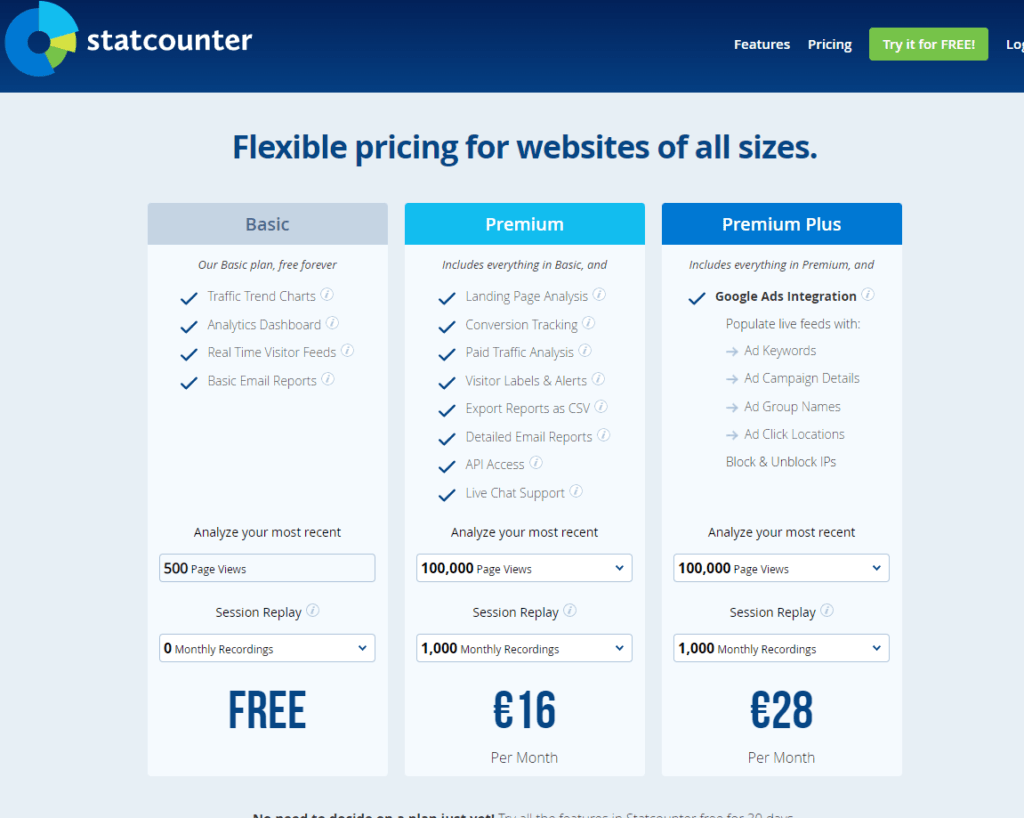In the vast expanse of digital tools, picking the right analytics platform can feel like finding a needle in a haystack. Today, we’re zeroing in on two contenders that have been on the lips of many: MicroStrategy and Statcounter. These tools are not just about numbers and graphs; they’re about understanding the story behind your data. So, grab a cup of coffee, and let’s delve into this head-to-head comparison to help you decide which analytics tool is the best fit for you.
| MicroStrategy | Statcounter |
|---|---|
 |  |
| G2 Score – 4.2 out of 5 stars | G2 Score – 4.3 out of 5 stars |
| TrustRadius Score – 8.4/10 | TrustRadius Score – 9/10 |
The Ease of Use and User Interface
When it comes to analytics tools, the ease of use and user interface (UI) are not just fancy terms. They are crucial for ensuring that you can navigate through mountains of data without feeling like you’re lost in the wilderness. Here, we pit MicroStrategy against Statcounter to see which platform offers a smoother ride.
MicroStrategy: The Corporate Giant
MicroStrategy, a behemoth in the business intelligence world, offers a robust analytics platform that’s designed with the enterprise user in mind. Its UI is sleek, professional, and packed with features that can slice and dice data in every way imaginable. However, this abundance of features comes with a learning curve that might be intimidating for beginners or small business owners. It’s like being handed the controls to a spaceship when you’ve only ever driven a car.
The dashboard and reporting features are where MicroStrategy shines. Customization is the name of the game here. You can tailor every aspect of your dashboard to fit your specific needs, from intricate data visualizations to predictive analytics. But remember, with great power comes great responsibility. The sheer amount of customization options means you’ll need to invest time in learning the platform to fully leverage its capabilities.
Statcounter: The Underdog with a Punch
On the flip side, Statcounter positions itself as the more accessible alternative. It’s like the friendly neighborhood café that knows your order by heart. The platform prides itself on its simplicity and ease of use. For small to medium-sized businesses or individuals just dipping their toes into web analytics, Statcounter offers a welcoming embrace.
The UI of Statcounter is straightforward, with a focus on providing the essential data at a glance. You won’t find the overwhelming array of features that MicroStrategy boasts, but that’s precisely the point. Statcounter strips down the analytics experience to the bare essentials, making it incredibly easy for newcomers to get up and running in no time. It’s all about giving you the information you need without the fluff.
The real-time analytics feature is a standout for Statcounter. Being able to see who is on your site, what they’re looking at, and where they’re coming from in real time is invaluable for quick decision-making. It’s like having a bird’s-eye view of your digital storefront, allowing you to react instantly to your audience’s behavior.
Data Accuracy and Reliability
Diving deeper into the comparison, let’s talk about something that’s the backbone of any analytics tool: data accuracy and reliability. It’s the difference between making decisions based on solid facts versus taking a shot in the dark. Let’s see how MicroStrategy and Statcounter stack up in this critical arena.
MicroStrategy: Precision Engineering
MicroStrategy prides itself on providing high-quality, accurate data that large enterprises can rely on for making crucial decisions. Its ability to integrate with a wide array of data sources, including real-time data streams, means that you’re not just looking at what happened but what’s happening now. This level of integration and sophistication ensures that the data you see is as close to the source and as accurate as possible.
One of the key features of MicroStrategy that enhances its data accuracy is its robust data warehousing capabilities. It allows for the consolidation of data from various sources into a single, coherent framework. This not only improves the accuracy but also the consistency of the data across the organization. It’s like having a master chef preparing your meal; you know every ingredient is carefully selected and perfectly measured.
However, the complexity of setting up and maintaining these integrations and warehouses can be a double-edged sword. While it ensures data accuracy, it also requires a significant investment in time and resources. The precision engineering of MicroStrategy’s data analytics platform is unmatched, but it demands a level of commitment to upkeep.
Statcounter: Quick and Nimble
Statcounter, with its focus on simplicity and immediate insights, offers a different approach to data accuracy. It may not have the heavy-duty data integration capabilities of MicroStrategy, but it provides reliable and accurate data for the scope it covers. For small to medium-sized businesses, this level of accuracy is often more than sufficient for making informed decisions.
The platform’s real-time data tracking ensures that you’re getting up-to-date information on your website’s traffic and user behavior. While it might not offer the depth of integration as MicroStrategy, the data it provides is reliable for its intended use case. It’s akin to a skilled home cook; the dishes may not be as complex, but they’re made with care and provide satisfaction.
Statcounter’s straightforward approach means that there’s less room for error in data collection and interpretation. The simplicity of its analytics reduces the risk of misinterpretation, making it a reliable tool for those who need to make quick, informed decisions without the need for deep data dives.
Data Integration and Support
In our increasingly interconnected digital world, the ability of an analytics tool to seamlessly integrate with other platforms and support a wide range of data sources is not just a nice-to-have; it’s essential. Here, we examine how MicroStrategy and Statcounter stack up in terms of data integration capabilities and the support they offer to users.
MicroStrategy: The Data Integration Powerhouse
MicroStrategy excels in the realm of data integration. It’s like the Swiss Army knife of analytics tools, equipped to handle almost any data source you throw at it. From databases and cloud sources to web services and even flat files, MicroStrategy can integrate with a broad spectrum of data sources, making it a versatile choice for organizations with complex data ecosystems.
One of the platform’s standout features is its “connectors” — pre-built integrations that allow users to quickly connect to popular business applications like Salesforce, Microsoft Dynamics, and Google Analytics. These connectors simplify the process of bringing together disparate data sources, enabling users to create a unified view of their business information.
Furthermore, MicroStrategy’s support for big data is worth noting. It can handle massive datasets with ease, thanks to its high-performance analytics engine. For enterprises that deal with voluminous data, this capability is a game-changer, allowing for the analysis of large datasets without significant performance issues.
Statcounter: Simplified Integration for Straightforward Needs
Statcounter, keeping in line with its user-friendly approach, offers a more straightforward integration experience. It’s designed to be easy to set up and start using with your website, requiring just a snippet of code to begin tracking visitor data. This simplicity is perfect for users who are not looking for complex data integration but rather a plug-and-play solution.
While Statcounter may not boast the extensive list of connectors and integrations that MicroStrategy offers, it covers the basics well. It integrates smoothly with websites and blogs, providing real-time data on visitor behavior, which is often all that small businesses and personal users need.
However, it’s important to note that Statcounter’s simplicity also means it might not be the best fit for organizations with complex data integration needs. Its strength lies in its ability to offer immediate, actionable insights for website and blog owners, rather than serving as a comprehensive business intelligence tool.

Related: Check out our free SEO suite

Analytics and Reporting Capabilities
The strength of an analytics tool lies in its ability to transform raw data into insights that can inform business strategies. Both MicroStrategy and Statcounter offer analytics and reporting features, but they cater to different needs and preferences.
MicroStrategy: Advanced Analytics for Data-Driven Enterprises
MicroStrategy is a powerhouse when it comes to analytics and reporting capabilities. It’s designed to serve enterprises with complex data environments, offering advanced analytics features that can handle vast datasets and complex analysis scenarios. MicroStrategy supports a wide range of analytics functionalities, including predictive analytics, machine learning models, and big data analytics.
One of the key strengths of MicroStrategy is its comprehensive reporting features. Users can create highly detailed and customizable reports that can include a variety of visualizations, from simple charts to complex interactive dashboards. These reports are not just visually appealing; they’re also deeply informative, capable of highlighting trends, patterns, and outliers in the data.
MicroStrategy also offers robust self-service analytics capabilities, allowing business users to explore data and generate insights without needing deep technical expertise. This democratization of data analysis helps organizations foster a data-driven culture, empowering decision-makers at all levels.
Statcounter: Real-Time Analytics for Immediate Insights
While MicroStrategy focuses on depth and complexity, Statcounter offers a different approach. Its strength lies in real-time analytics, providing immediate insights into website performance and visitor behavior. This immediacy is crucial for small businesses and individual users who need to make quick decisions based on the latest data.
Statcounter’s reporting capabilities are designed to be straightforward and accessible. Users can quickly generate reports that provide essential insights into their website’s traffic, including page views, unique visitors, and the geographical location of visitors. These reports are easy to understand and act upon, making Statcounter an invaluable tool for users without a background in data analysis.
Another advantage of Statcounter is its focus on user experience. The platform’s reports are not just simple; they’re also designed with the user in mind, ensuring that even the most non-technical users can derive value from the insights presented.
Pricing and Scalability
In the digital age, where businesses evolve at breakneck speeds, the pricing models and scalability of digital tools are more important than ever. Let’s see how MicroStrategy and Statcounter measure up in this regard.
MicroStrategy: Enterprise-Level Pricing with Scalable Architecture

MicroStrategy is tailored towards enterprises and large organizations, and its pricing reflects that. It offers a comprehensive analytics platform that comes with an enterprise-level price tag. The exact cost can vary widely depending on the scale of deployment, the number of users, and the specific features and services required. It’s a bit like ordering a custom suit — the final price depends on the choices you make.
However, what you get for this price is a highly scalable solution that can grow with your organization. MicroStrategy’s architecture is designed for scalability, capable of handling everything from small datasets to massive enterprise-level data warehouses. This scalability is a significant advantage for organizations that anticipate growth and require a tool that can expand to meet increasing data demands.
Moreover, MicroStrategy offers cloud-based, on-premise, and hybrid deployment options, providing flexibility to meet various IT and security requirements. This flexibility, combined with its robust scalability, makes MicroStrategy a long-term investment that can adapt to your organization’s changing needs.
Statcounter: Affordable Pricing for Small Businesses and Individuals

Statcounter presents a stark contrast to MicroStrategy’s enterprise-focused pricing model. It is designed with small businesses, bloggers, and individual users in mind, offering a more affordable and straightforward pricing structure. Statcounter’s services start with a free version, which includes basic features suitable for small websites. For more advanced features and higher data limits, it offers several tiered pricing plans that are significantly lower in cost compared to MicroStrategy.
The appeal of Statcounter lies not just in its affordability but also in its simplicity. The pricing plans are easy to understand, with clear distinctions between the different tiers. This transparency makes it easier for small businesses and individual users to choose a plan that fits their needs without overcommitting resources.
While Statcounter is highly effective for its intended audience, it’s worth noting that its scalability is more limited than MicroStrategy’s. It’s perfect for websites and small-scale projects, but as your data needs grow, you might find yourself outgrowing Statcounter. This doesn’t detract from its value for its target market, but it’s an essential factor to consider for long-term planning.
Conclusion
MicroStrategy emerges as a powerhouse for enterprises and large organizations, offering a deep well of functionalities, extensive data integration options, and robust scalability. It’s designed for those who need a comprehensive analytics platform capable of handling complex data analysis and visualization at an enterprise scale. While its cost and learning curve may be steep, the investment can provide significant returns for organizations that require its advanced capabilities.
Statcounter shines as a straightforward, user-friendly tool perfect for small businesses, bloggers, and individual website owners. Its simplicity, affordability, and real-time analytics make it an excellent choice for those who need to understand their web traffic without the complexities of a full-scale business intelligence tool. Though it may not offer the scalability and depth of features found in MicroStrategy, Statcounter excels in delivering immediate value and ease of use to its target audience.
Read Next:
- The Role of Visuals in Email Marketing: Enhancing Engagement with Images and GIFs
- Email Marketing for Subscription-Based Services
- Crafting Compelling Email Subject Lines: Tips and Tricks for Higher Open Rates
- The Importance of Deliverability in Email Marketing: Ensuring Your Messages Reach the Inbox
- 31+ Top Social Media Management tools Compared! (2023)






















Comments are closed.